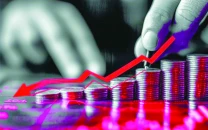Bigger lies in statistics
Overuse of numbers for political point-scoring affects credibility of economic management

One of the statistical jokes says that if your one foot is on fire and the other on ice, you should feel comfortable on average, and that is what an average Pakistani is supposed to feel if we go by statistics on our economy.
Moreover, every Pakistani got richer overnight, a few days ago, if we go by the latest gross domestic product (GDP) statistics.
It will take a bit of time for serious economists to absorb and understand this miraculous increase in GDP, which is due to the rebasing of reporting period but being portrayed as actual growth. However, miracles do happen, particularly in current times.
Statistics and numbers are new weapons of mass (mis)information. With extremely plausible levels of flexibility, one may come up with desired results and picture to highlight. Does it reflect the ground reality though? Not always.
Let us start with the numbers of record-breaking economic achievements that one can witness in media recently. Every other day something is achieved as a new record, but a layman would ask what does it mean really?
If we have record revenue collection of Rs4.7 trillion today, then the addition of one rupee tomorrow would be a new record, and so on. So is the case with the production numbers.
Does it make any sense to report records that are being broken every next moment? Moreover, is it guaranteed that this record level would go only higher in future? What if this record moves downwards, would it be reported instantly?
Next is the frequently used narrative of percentage increase in different economic indicators.
The headline numbers with reasonable reporting periods, such as annual growth in GDP, exports, revenue, etc are considered normal to be reported but a flurry of reporting of indicators with flashy growth percentages results in loss of credibility and seriousness when one digs deep into such reporting, for that such flashy numbers are comparisons with an insignificant base period or comparisons.
For example, in November 2021, the exports increased by 36%, and a normal citizen would think that exports have really increased by this percentage while, in fact, it was an increase as compared to November 2020 when supply chains were more strained due to Covid-19. So is the case for many other growth numbers.
Another aspect of the statistics saga is a mismatch among reporting institutions. Most of the time, we heard the disparity of GDP growth numbers of the State Bank versus the Planning Division and certainly the numbers reported by the external observers.
This is probably a result of less developed data collection and reporting system in Pakistan. We need to strengthen it, particularly the economic data.
Many a time, rather disproportionately more often, we resort to mirror data and projections, which is not a preferred method in this age of digitisation and other advanced statistical tools and models.
We also need to focus on accounting for the informal economy, which has been a longstanding item on the to-do list of successive governments. This is essential for a proper economic policy design and management.
Next item in this context is the transparency of data. While we have access to the headline numbers such as the elements of GDP, etc, our citizens must know few other statistics as well.
For example, a detailed list of loans written off every year, particularly by state-owned financial institutions, numbers of subsidies (direct and indirect) given to major economic sectors, detailed list of external and domestic public debt including the name of creditors, not only the billions earned from exports of fabrics but the billions that are given as direct and indirect subsidies, not only the record number of cars produced in a year but the real value addition in the country and the numbers of payments for imported items and premium paid to parent companies, inter alia.
It would be interesting to know the growth and percentages of these statistics.
For the headline or main economic statistics, such as GDP, it would be better to report data at disaggregated levels as possible. Averages do not convey a true picture.
We should also focus a bit more on collecting and reporting the human development indicators and not only hardcore economic numbers. A development policy design needs a good level of data and evidence of social and development indicators.
Use of statistics and numbers for political point-scoring is not unheard of, but their overuse affects the credibility and seriousness of economic management.
If someone maps out all of the reported numbers, particularly through tweets, and then corroborate those to check accuracy and actual numbers on an annual basis, the most probable result would be a big surprise to say the least.
One may hope to expect seriousness in the reporting of economic statistics at least, if not policies and management.
The writer is an international economist
Published in The Express Tribune, February 7th, 2022.
Like Business on Facebook, follow @TribuneBiz on Twitter to stay informed and join in the conversation.



















COMMENTS
Comments are moderated and generally will be posted if they are on-topic and not abusive.
For more information, please see our Comments FAQ